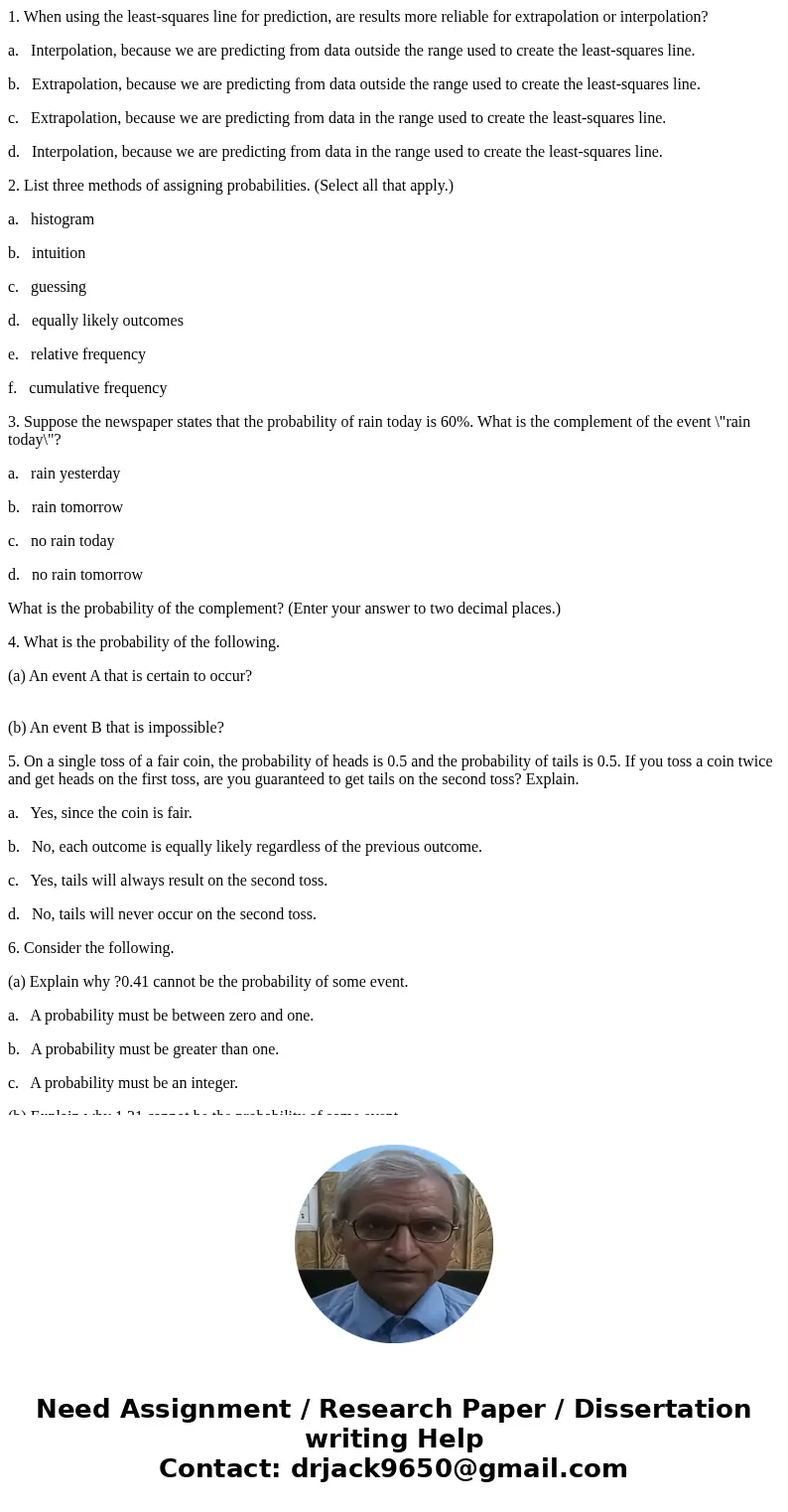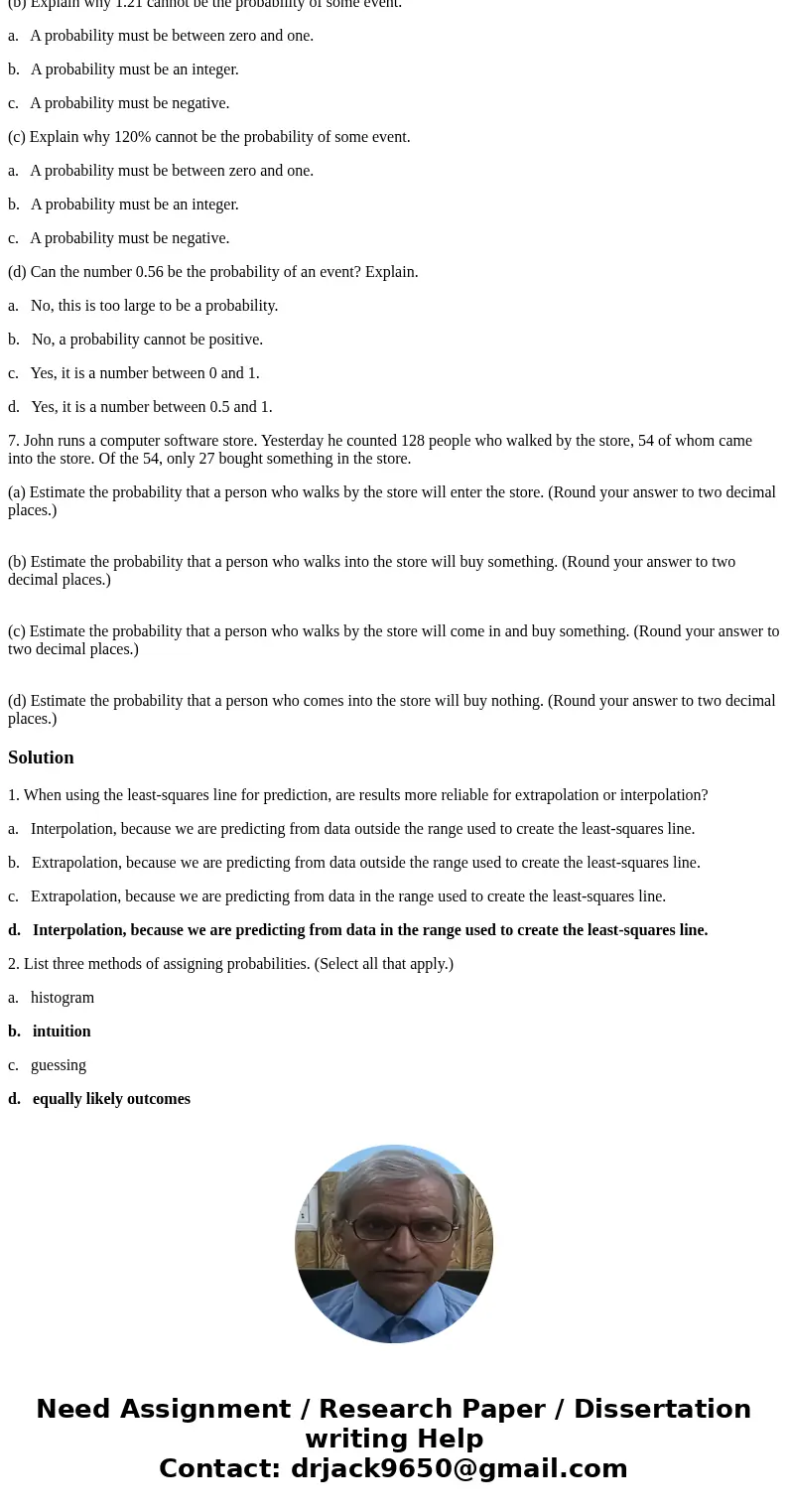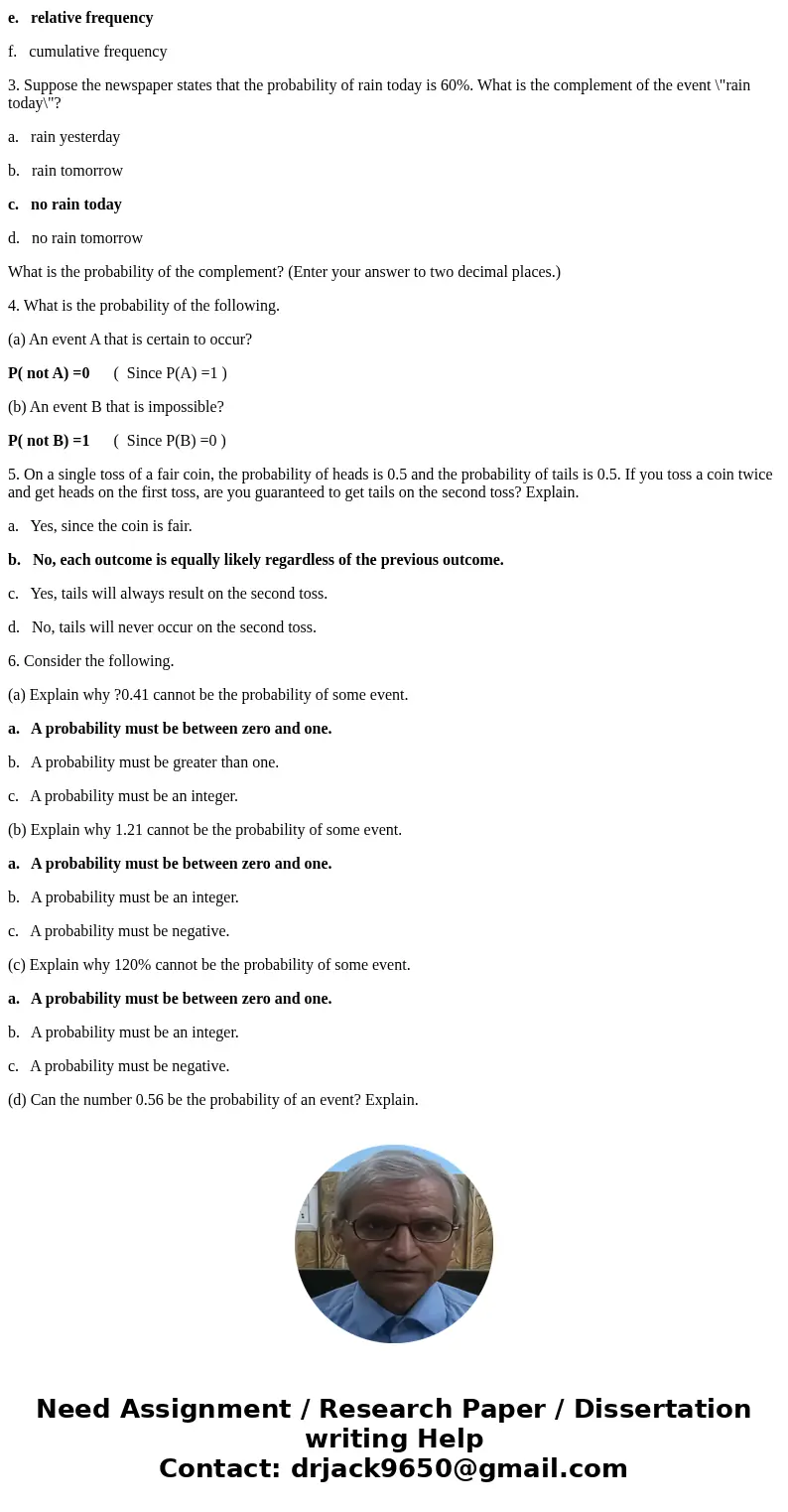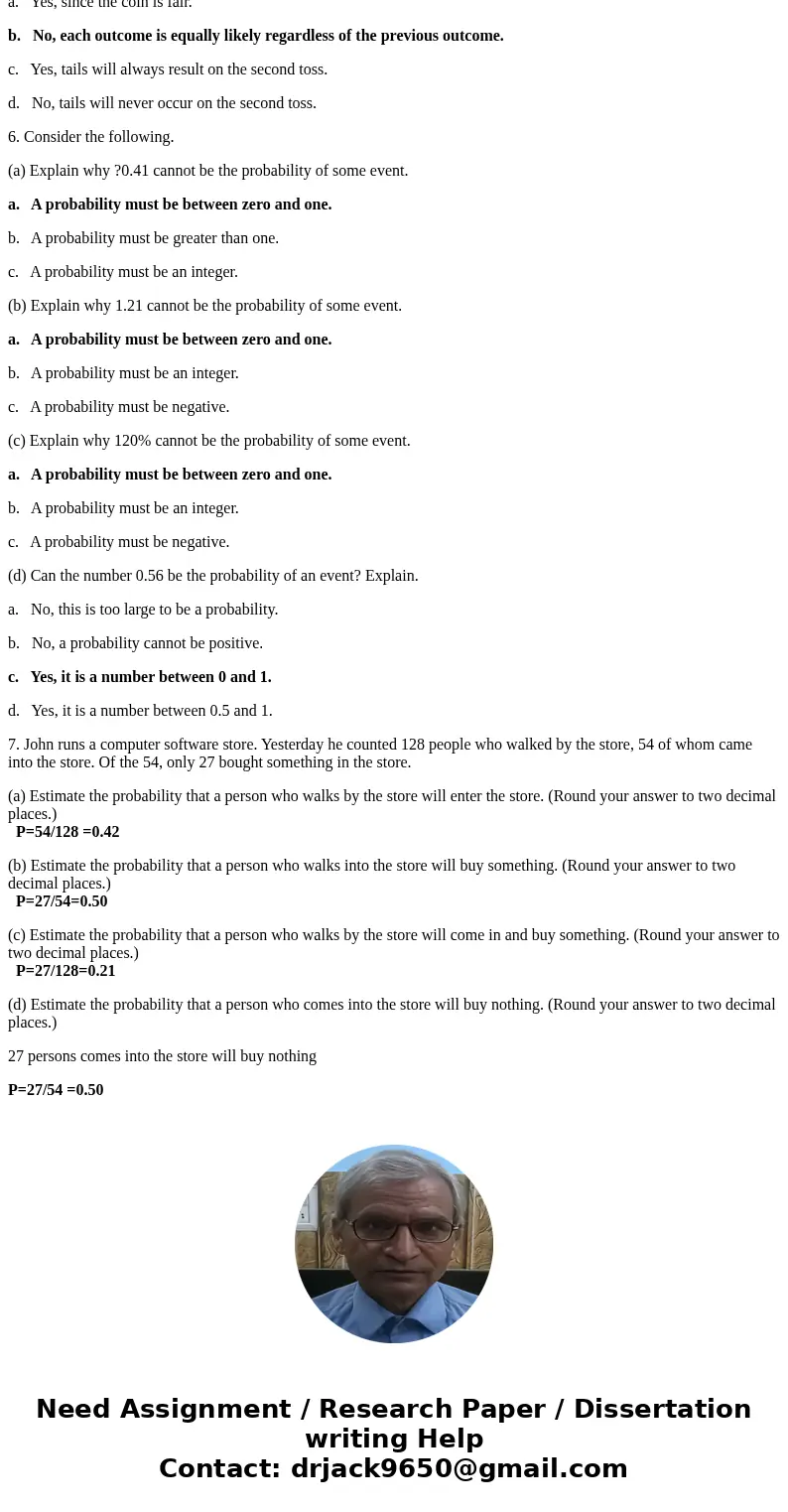1 When using the leastsquares line for prediction are result
1. When using the least-squares line for prediction, are results more reliable for extrapolation or interpolation?
a. Interpolation, because we are predicting from data outside the range used to create the least-squares line.
b. Extrapolation, because we are predicting from data outside the range used to create the least-squares line.
c. Extrapolation, because we are predicting from data in the range used to create the least-squares line.
d. Interpolation, because we are predicting from data in the range used to create the least-squares line.
2. List three methods of assigning probabilities. (Select all that apply.)
a. histogram
b. intuition
c. guessing
d. equally likely outcomes
e. relative frequency
f. cumulative frequency
3. Suppose the newspaper states that the probability of rain today is 60%. What is the complement of the event \"rain today\"?
a. rain yesterday
b. rain tomorrow
c. no rain today
d. no rain tomorrow
What is the probability of the complement? (Enter your answer to two decimal places.)
4. What is the probability of the following.
(a) An event A that is certain to occur?
(b) An event B that is impossible?
5. On a single toss of a fair coin, the probability of heads is 0.5 and the probability of tails is 0.5. If you toss a coin twice and get heads on the first toss, are you guaranteed to get tails on the second toss? Explain.
a. Yes, since the coin is fair.
b. No, each outcome is equally likely regardless of the previous outcome.
c. Yes, tails will always result on the second toss.
d. No, tails will never occur on the second toss.
6. Consider the following.
(a) Explain why ?0.41 cannot be the probability of some event.
a. A probability must be between zero and one.
b. A probability must be greater than one.
c. A probability must be an integer.
(b) Explain why 1.21 cannot be the probability of some event.
a. A probability must be between zero and one.
b. A probability must be an integer.
c. A probability must be negative.
(c) Explain why 120% cannot be the probability of some event.
a. A probability must be between zero and one.
b. A probability must be an integer.
c. A probability must be negative.
(d) Can the number 0.56 be the probability of an event? Explain.
a. No, this is too large to be a probability.
b. No, a probability cannot be positive.
c. Yes, it is a number between 0 and 1.
d. Yes, it is a number between 0.5 and 1.
7. John runs a computer software store. Yesterday he counted 128 people who walked by the store, 54 of whom came into the store. Of the 54, only 27 bought something in the store.
(a) Estimate the probability that a person who walks by the store will enter the store. (Round your answer to two decimal places.)
(b) Estimate the probability that a person who walks into the store will buy something. (Round your answer to two decimal places.)
(c) Estimate the probability that a person who walks by the store will come in and buy something. (Round your answer to two decimal places.)
(d) Estimate the probability that a person who comes into the store will buy nothing. (Round your answer to two decimal places.)
Solution
1. When using the least-squares line for prediction, are results more reliable for extrapolation or interpolation?
a. Interpolation, because we are predicting from data outside the range used to create the least-squares line.
b. Extrapolation, because we are predicting from data outside the range used to create the least-squares line.
c. Extrapolation, because we are predicting from data in the range used to create the least-squares line.
d. Interpolation, because we are predicting from data in the range used to create the least-squares line.
2. List three methods of assigning probabilities. (Select all that apply.)
a. histogram
b. intuition
c. guessing
d. equally likely outcomes
e. relative frequency
f. cumulative frequency
3. Suppose the newspaper states that the probability of rain today is 60%. What is the complement of the event \"rain today\"?
a. rain yesterday
b. rain tomorrow
c. no rain today
d. no rain tomorrow
What is the probability of the complement? (Enter your answer to two decimal places.)
4. What is the probability of the following.
(a) An event A that is certain to occur?
P( not A) =0 ( Since P(A) =1 )
(b) An event B that is impossible?
P( not B) =1 ( Since P(B) =0 )
5. On a single toss of a fair coin, the probability of heads is 0.5 and the probability of tails is 0.5. If you toss a coin twice and get heads on the first toss, are you guaranteed to get tails on the second toss? Explain.
a. Yes, since the coin is fair.
b. No, each outcome is equally likely regardless of the previous outcome.
c. Yes, tails will always result on the second toss.
d. No, tails will never occur on the second toss.
6. Consider the following.
(a) Explain why ?0.41 cannot be the probability of some event.
a. A probability must be between zero and one.
b. A probability must be greater than one.
c. A probability must be an integer.
(b) Explain why 1.21 cannot be the probability of some event.
a. A probability must be between zero and one.
b. A probability must be an integer.
c. A probability must be negative.
(c) Explain why 120% cannot be the probability of some event.
a. A probability must be between zero and one.
b. A probability must be an integer.
c. A probability must be negative.
(d) Can the number 0.56 be the probability of an event? Explain.
a. No, this is too large to be a probability.
b. No, a probability cannot be positive.
c. Yes, it is a number between 0 and 1.
d. Yes, it is a number between 0.5 and 1.
7. John runs a computer software store. Yesterday he counted 128 people who walked by the store, 54 of whom came into the store. Of the 54, only 27 bought something in the store.
(a) Estimate the probability that a person who walks by the store will enter the store. (Round your answer to two decimal places.)
P=54/128 =0.42
(b) Estimate the probability that a person who walks into the store will buy something. (Round your answer to two decimal places.)
P=27/54=0.50
(c) Estimate the probability that a person who walks by the store will come in and buy something. (Round your answer to two decimal places.)
P=27/128=0.21
(d) Estimate the probability that a person who comes into the store will buy nothing. (Round your answer to two decimal places.)
27 persons comes into the store will buy nothing
P=27/54 =0.50




 Homework Sourse
Homework Sourse